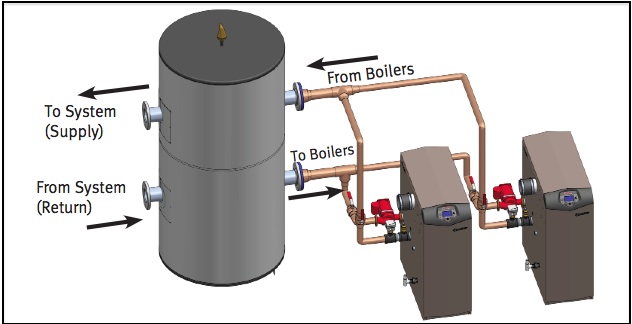Condensing Boiler Plant Piping Design & Control Part 5: How To Size a Buffer Tank
/By Chad Edmondson
Short cycling isn’t good for any type of boiler system. It decreases efficiency and it causes wear and tear on the boiler. Short cycling is of particular concern with condensing boiler systems for all of the reasons we have discussed in previous blogs. The lower water volume associated with condensing boilers systems can result in rapid increases the water temperature, which can cause the boiler to prematurely cycle off (or worse) go off on high limit. An appropriately sized buffer tank is often the answer.
When Is a Buffer Tank Required?
Not every boiler system requires a buffer tank – but some do. So how do you know if a buffer tank is needed for your particular boiler system or boiler plant design?
A buffer tank is required when there is not enough water volume in the system to absorb the excess heat from the boiler during operation or during start-up firing. In other words, if the minimum boiler output is greater than the minimum system load and the water volume in the system is so minor that it cannot hold the extra Btus without the water temperature spiking and causing the boiler to cycle rapidly cycle off, then you need a buffer tank. A buffer tank can store these surplus Btus, which can be used to serve smaller loads without ever involving the boiler – thus keeping it off and on for longer periods of time.
Sizing a Buffer Tank
To properly size a buffer tank, you need to know the following:
The minimum desired run time for your boilers – typically 10 minutes for most condensing boilers
The minimum output (Btu/h) of your particular boilers. (Remember – this isn’t necessarily the lowest fire rate your boilers can produce, but the start-up rate, which can be higher than the lowest fire rate.)
The minimum system load (Btu/h) based on the zone with the least possible demand.
The system ∆T (°F) at minimum system load.
With these values you can complete the following equation, which will result in the gallon size necessary to satisfy your needs for Btu storage in water.
The 8.33 value is a constant based on the fact that it takes 8.33 Btus to raise a single gallon of water by one degree. The “60” is another fixed value which simply refers to the number of minutes in an hour.
Do the simple math and the resulting value will be the number of gallons your buffer tank must be able to hold to prevent your system from short cycling!




